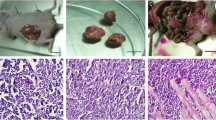Abstract
Studies were made to determine whether the orthotopic implantation of human renal cell carcinoma cells (HRCC) into nude mice will produce distant metastases, thus allowing for the selection of variant cells with high metastatic potential. The parental SN12C line was established in culture from a surgical specimen of HRCC. The renal subcapsule (RSC) of adult nude mice was injected with SN12C cells; the mice were killed when they became moribund. Cell lines were established from either single or multiple lung HRCC metastases. The intravenous injection of many (but not all) of the metastasis-derived lines produced significantly more experimental metastases than did the parental cells. The injection of cells into the RSC demonstrated that, in general, cells derived from spontaneous metastases were more metastatic than cells of the parental line. Hence adult nude mice can be used to select HRCC cells with high metastatic potential. These HRCC variant lines offer a good model for studying the cell properties of metastatic HRCC.
Similar content being viewed by others
Abbreviations
- EMEM:
-
Eagle's minimum essential medium
- HBSS:
-
Hank's balanced salt solution without Ca2+ and Mg2+
- HRCC:
-
human renal cell carcinoma
- RSC:
-
renal subcapsule
References
Fidler, I. J., andHart, I. R., 1982, Biological diversity in metastatic neoplasms: origins and implications.Science,217, 998–1003.
Heppner, G., 1984, Tumor heterogeneity.Cancer Research,44, 2259–2265.
Nicolson, G. L., 1984, Generation of phenotypic diversity and progression in metastatic tumors.Cancer and Metastasis Reviews,3, 25–42.
Fidler, I. J., andPoste, G., 1985, The cellular heterogeneity of malignant neoplasms: implications for adjuvant chemotherapy.Seminars in Oncology,12, 207–221.
Poste, G., 1986, Pathogenesis of metastatic disease: implications for current therapy and for the development of new therapeutic strategies.Cancer Treatment Reports,70, 1223–1227.
Nicolson, G. L., 1987, Tumor cell instability, diversification and progression to the metastatic phenotype: from oncogene to oncofetal expression.Cancer Research,47, 1473–1487.
Fidler, I. J., andBalch, C. M., 1987, The biology of cancer metastasis and implications for therapy.Current Problems in Surgery,24, 137–209.
Fidler, I. J., andKripke, M., 1977, Metastasis results from pre-existing variant cells within a malignant tumor.Science,197, 893–895.
Sordat, B., Fritsche, R., andMach, P., 1974, Morphological and functional evaluation of human solid tumors serially transplanted in nude mice.Proceedings of the First International Workshop on Nude Mice, edited by J. Rygaard and C. O. Povlsen (Stuttgart: Fisher), pp. 269–277.
Povlsen, C. O., andRygaard, J., 1976, Growth of human tumors in the nude mouse. In vitroMethods of Cell-mediated and Tumor Immunity, edited by B. B. Bloom and J. R. David (New York: Academic Press), pp. 701–711.
Sharkey, F. E., andFogh, J., 1979, Metastasis of human tumors in athymic nude mice.International Journal of Cancer,24, 733–738.
Fidler, I. J., 1986, Rationale and methods for the use of nude mice to study the biology and therapy of human cancer metastasis.Cancer and Metastasis Reviews,5, 29–49.
Naito, S., Giavazzi, R., Walker, S. M., Itoh, K., Mayo, J., andFidler, I. J., 1987, Growth and metastatic behavior of human tumor cells implanted into nude and beige nude mice.Clinical and Experimental Metastasis,5, 135–146.
Hanna, N., 1982, Role of natural killer cells in control of cancer metastasis.Cancer and Metastasis Reviews,1, 45–65.
Giavazzi, R., Campbell, D. E., Jessup, J. M., Cleary, K., andFidler, I. J., 1986, Metastatic behavior of tumor cells isolated from primary and metastatic human colorectal carcinomas implanted into different sites in nude mice.Cancer Research,46, 1928–1933.
Giavazzi, R., Jessup, J. M., Campbell, D. E., Walker, S. M., andFidler, I. J., 1986, Experimental nude mouse model of human colorectal cancer liver metastases.Journal of the National Cancer Institute,77, 1303–1308.
Naito, S., Von Eschenbach, A. C., Giavazzi, R., andFidler, I. J., 1986, Growth and metastasis of tumor cells isolated from a human renal cell carcinoma implanted into different organs of nude mice.Cancer Research,46, 4109–4115.
Naito, S., Von Eschenbach, A. C., andFidler, I. J., 1987, Different growth pattern and biologic behavior of human and renal cell carcinoma implanted into different organs of the nude mice.Journal of the National Cancer Institute,78, 377–385.
Morikawa, K., Walker, S. M., Jessup, J. M., andFidler, I. J., 1988,In vivo selection of highly metastatic cells from surgical specimens of different primary human colon carcinomas implanted into nude mice.Cancer Research,48, 1943–1948.
Kozlowski, J. M., Hart, I. R., Fidler, I. J., andHanna, N., 1984, A human melanoma line heterogeneous with respect to metastatic capacity in athymic nude mice.Journal of the National Cancer Institute,72, 913–917.
Kozlowski, J. M., Fidler, I. J., Campbell, D., Xu, Z., Kaighn, M. E., andHart, I. R., 1984, Metastatic behavior of human tumor cell lines grown in the nude mouse.Cancer Research,44, 3522–3529.
Poste, G., Doll, J., andFidler, I. J., 1981, Interactions between clonal subpopulations affect the stability of the metastatic phenotype in polyclonal populations of B16 melanoma cells.Proceedings of the National Academy of Sciences of the U.S.A.,78, 6226–6230.
Nicolson, G. L., andCustead, S. E., 1982, Tumor metastasis is not due to adaptation of cells to a new organ environment.Science,215, 176–178.
Fidler, I. J., 1984, The Ernst W. Bertner Memorial Award Lecture: The evolution of biological heterogeneity in metastatic neoplasm.Cancer Invasion and Metastasis: Biologic and Therapeutic Aspects, edited by G. L. Nicolson and L. Milas (New York: Raven Press), pp. 5–26.
Talmadge, J. E., andFidler, I. J., 1982, Cancer metastasis is selective or random depending on the parent tumor population.Nature (London),297, 593–594.
Price, J. E., Aukerman, S. L., andFidler, I. J., 1986, Evidence that the process of murine melanoma metastasis is sequential and selective and contains stochastic elements.Cancer Research,46, 5172–5178.
Raz, A.,Hanna, N., andFidler, I. J.,In vivo isolation of a metastatic tumor cell variant involving selective and nonadaptive process.Journal of the National Cancer Institute,66, 183–189.
Author information
Authors and Affiliations
Rights and permissions
About this article
Cite this article
Naito, S., Walker, S.M. & Fidler, I.J. In vivo selection of human renal cell carcinoma cells with high metastatic potential in nude mice. Clin Exp Metast 7, 381–389 (1989). https://doi.org/10.1007/BF01753659
Received:
Accepted:
Issue Date:
DOI: https://doi.org/10.1007/BF01753659




